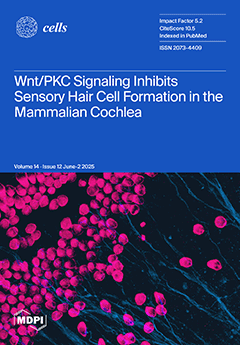Aldehyde dehydrogenase 2 (ALDH2) is a crucial detoxifying enzyme that eliminates toxic aldehydes. ALDH2 deficiency has been linked to various human diseases, including certain cancers. We have previously reported
ALDH2 downregulation in human melanoma tissues. Here, we further investigated the biological significance of
[...] Read more.
Aldehyde dehydrogenase 2 (ALDH2) is a crucial detoxifying enzyme that eliminates toxic aldehydes. ALDH2 deficiency has been linked to various human diseases, including certain cancers. We have previously reported
ALDH2 downregulation in human melanoma tissues. Here, we further investigated the biological significance of
ALDH2 downregulation in this malignancy. Analysis of TCGA dataset revealed that low
ALDH2 expression correlates with poorer survival in metastatic melanoma. Examination of human metastatic melanoma cell lines confirmed that most had
ALDH2 downregulation (
ALDH2-low) compared to primary melanocytes. In contrast, a small subset of metastatic melanoma cell lines exhibited normal
ALDH2 levels (
ALDH2-normal). CRISPR/Cas9-mediated
ALDH2 knockout in
ALDH2-normal A375 cells promoted tumor growth and MAPK/ERK activation. Given the pivotal role of MAPK/ERK signaling in melanoma and cellular response to acetaldehyde, we compared A375 with
ALDH2-low SK-MEL-28 and 1205Lu cells.
ALDH2-low cells were intrinsically resistant to BRAF and MEK inhibitors, whereas A375 cells were not. However, A375 cells acquired resistance upon
ALDH2 knockout. Furthermore, melanoma cells with acquired resistance to these inhibitors displayed further ALDH2 downregulation. Our findings indicate that
ALDH2 downregulation contributes to melanoma progression and therapy resistance in
BRAF-mutated human metastatic melanoma cells, highlighting ALDH2 as a potential prognostic marker and therapeutic target in metastatic melanoma.
Full article






